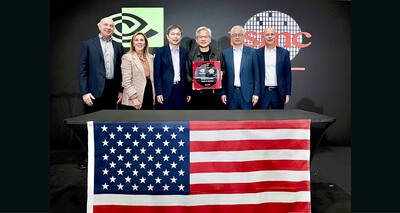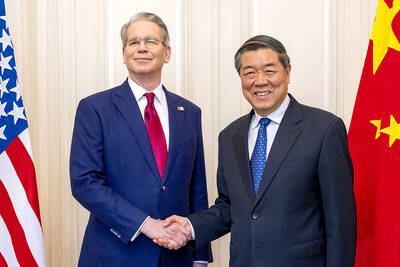Powertech Technology Inc (力成), a memorychip tester and packager, yesterday said revenue this quarter is expected to grow by between 5 percent and 10 percent from last quarter’s NT$9.43 billion (US$306.65 million) on the back of strong demand for DRAM for mobile devices and graphics.
Sales for last month outpaced the NT$3.28 billion made in March, president Hung Jia-yu told an investors conference.
Sales of flash memory products accounted for 40 percent of Powertech’s total revenue last quarter, and is expected to grow this quarter and next quarter, due to strong orders for high-end smartphones from Powertech’s existing clients, Hung said.
However, revenue generated from sales of logic integrated circuit (IC) products is likely to be flat this quarter from last quarter, but might gain steam next quarter on recovering demand from clients, Hung said.
Logic IC products accounts for about 30 percent of the company’s total sales.
“The higher average selling prices of the advanced DRAM business for mobile and graphics will also help the company’s gross margin continue to improve from this quarter,” Hung said.
Powertech’s gross margin for the first quarter of the year improved 3.2 percentage points to 17.7 percent from a year ago, due to the firm’s efforts in reducing costs and improved product mix, Hung said.
Gross margin increased 1.5 percentage points from the previous quarter’s 16.2 percent, he said.
That helped the company achieve a better-than-expected 29.1 percent annual increase in net income to NT$771 million last quarter, or NT$1.01 per share.
The company said its earnings growth last quarter also reflected strong performance in the DRAM segment.
“The new plant in Xian, China, that is in partnership with US-based Micron Technology Inc has made significant contribution to DRAM sales last quarter,” chairman Tsai Du-kung (蔡篤恭) said.
Overall, revenue contribution from DRAM increased to 30 percent of total revenue last quarter from 26 percent in the previous quarter, the company said.
The company aims to continue improving its gross margin this year and develop new technologies with major clients to catch the market trends in the next few years, Tsai said.
Meanwhile, the company’s board has approved the distribution of a cash dividend of NT$3 per share based on last year’s net profit of NT$4.42 billion, or NT$4.24 per share, with a payout ratio of 70.75 percent.
The planned cash dividend suggested a dividend yield of 5.28 percent, based on the company’s closing share price of NT$56.8 yesterday in Taipei trading.
Hung said that Powertech plans to maintain a high dividend payout policy.

Jensen Huang (黃仁勳), founder and CEO of US-based artificial intelligence chip designer Nvidia Corp and Taiwan Semiconductor Manufacturing Co (TSMC, 台積電) on Friday celebrated the first Nvidia Blackwell wafer produced on US soil. Huang visited TSMC’s advanced wafer fab in the US state of Arizona and joined the Taiwanese chipmaker’s executives to witness the efforts to “build the infrastructure that powers the world’s AI factories, right here in America,” Nvidia said in a statement. At the event, Huang joined Y.L. Wang (王英郎), vice president of operations at TSMC, in signing their names on the Blackwell wafer to

AI BOOST: Although Taiwan’s reliance on Chinese rare earth elements is limited, it could face indirect impacts from supply issues and price volatility, an economist said DBS Bank Ltd (星展銀行) has sharply raised its forecast for Taiwan’s economic growth this year to 5.6 percent, citing stronger-than-expected exports and investment linked to artificial intelligence (AI), as it said that the current momentum could peak soon. The acceleration of the global AI race has fueled a surge in Taiwan’s AI-related capital spending and exports of information and communications technology (ICT) products, which have been key drivers of growth this year. “We have revised our GDP forecast for Taiwan upward to 5.6 percent from 4 percent, an upgrade that mainly reflects stronger-than-expected AI-related exports and investment in the third

France cannot afford to ignore the third credit-rating reduction in less than a year, French Minister of Finance Roland Lescure said. “Three agencies have downgraded us and we can’t ignore this cloud,” he told Franceinfo on Saturday, speaking just hours after S&P lowered his country’s credit rating to “A+” from “AA-” in an unscheduled move. “Fundamentally, it’s an additional cloud to a weather forecast that was already pretty gray. It’s a call for lucidity and responsibility,” he said, adding that this is “a call to be serious.” The credit assessor’s move means France has lost its double-A rating at two of the

RARE EARTHS: The call between the US Treasury Secretary and his Chinese counterpart came as Washington sought to rally G7 partners in response to China’s export controls China and the US on Saturday agreed to conduct another round of trade negotiations in the coming week, as the world’s two biggest economies seek to avoid another damaging tit-for-tat tariff battle. Beijing last week announced sweeping controls on the critical rare earths industry, prompting US President Donald Trump to threaten 100 percent tariffs on imports from China in retaliation. Trump had also threatened to cancel his expected meeting with Chinese President Xi Jinping (習近平) in South Korea later this month on the sidelines of the APEC summit. In the latest indication of efforts to resolve their dispute, Chinese state media reported that